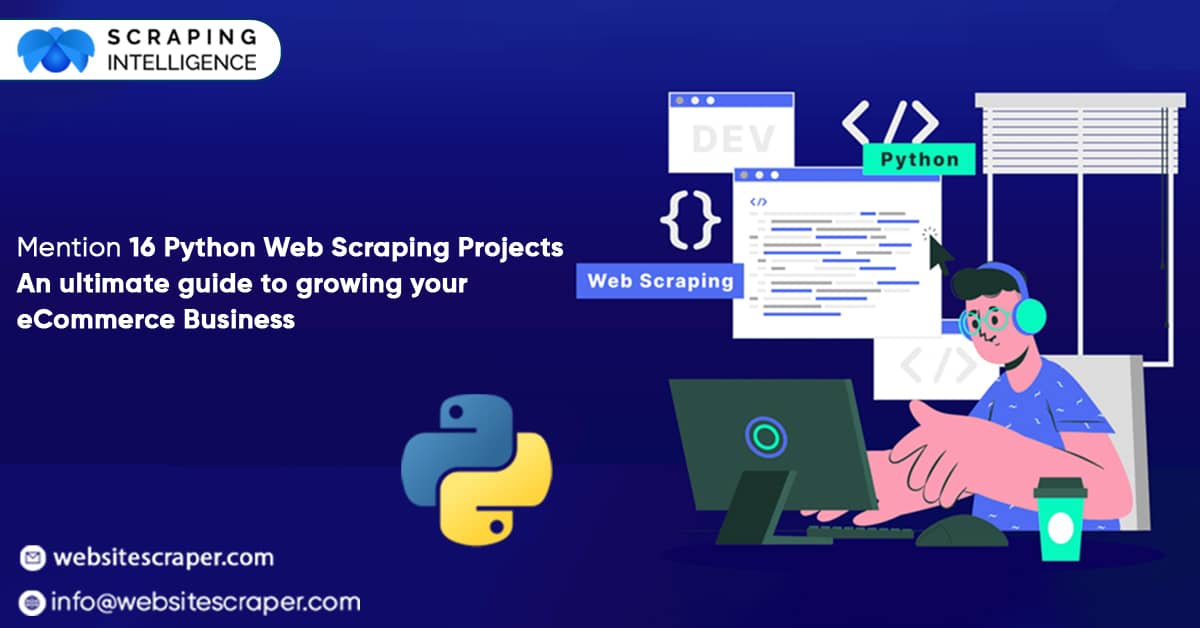
Introduction to Web Scraping with Python

Web scraping is also known as web data extraction or harvesting. Powerful libraries and frameworks that easily pull data from HTML and XML documents make Python one of the most popular programming languages for web scraping.
The first step in web scraping with Python is sending an HTTP request to a site's server to extract a web page's HTML or XML code. Web scraping is for many purposes, including sentiment analysis, pricing comparison, data mining, etc.
The workflow of Web Scraping
The core workflow for web scraping consists of these phases. However, depending on the requirements, it can be tricky.
Identifying the target website: The first step is to identify the website from which you want to extract data.
Inspecting the web page: Once the target website is known, the next step is to look through the web page's source code to find the HTML parts that have the data you wish to extract.
Creating a request: In the next step, you'll use a Python library as a request to send an HTTP request to the website's server.
Extracting the data: In this step, you will extract and drag the data to store it in a variable.
Saving the data: Once extracted, keep it in various formats, such as Excel.
Cleaning the data: You need to clean the extracted data before we can analyze it or use it for other purposes, as it contains unwanted information.
Analyzing the data: You can examine it and gain insights after cleansing.
How to set up a Web Scraping Python Project?

Setting up a web scraping Python project involves the following steps:
Please create a new project folder: Create a new folder to hold onto your files, giving it a meaningful name that reflects the project's purpose.
Create a virtual environment: It is an excellent approach to creating a virtual environment for your Python project. It will allow you to install and manage the project's dependencies separately from your system's Python installation.
Activate the virtual environment: After creation, activate it to begin utilizing it by issuing the relevant operating-system command.
Install the required libraries: The next step is to install the libraries needed for your project, which are requests, BeautifulSoup, and XML.
Create a new Python file: Create a new Python file in your project folder and name it, which will be the main script for your web scraping project.
Import the libraries: Import the libraries you installed in the previous step.
Write your scraping code: You can start writing the code for your web scraping project.
Run the script: Run it to see the results. Print the extracted data to the screen if everything goes well.
Automate the scraping: Once you have verified that the script is working correctly, you can schedule it to run automatically at a specific time or interval. After following the automation process, you can save the file in whichever format you need.
Setting up a Python project for web scraping is relatively straightforward. However, it depends on the demand for the data and how complex the scraping task is.
Top 16 Web Scraping Python Projects:

Scraping product information and pricing data from e-commerce websites to compare prices and make informed purchasing decisions
- Extracting customer reviews and ratings from e-commerce websites to gather product feedback and improve product listings
- Scraping product images and descriptions of building a product catalogue
- Extracting data on competitors' prices, product offerings, and marketing strategies to inform business decisions
- Scraping data on popular trends and products to inform product development and marketing efforts
- Extracting data on shipping costs and delivery times to optimise logistics and improve customer satisfaction
- Scraping data on social media conversations and mentions of the brand to enhance social media marketing efforts
- Extracting data on search engine rankings and website traffic to inform SEO and SEM strategies
- Scraping data on customer demographics and purchasing habits to inform targeted marketing campaigns
- Extracting data on industry news and events to stay up-to-date on the latest developments in the field
- Scraping data on job listings and salaries to announce hiring and compensation strategies
- Scraping data on political and economic conditions to inform business strategies and decisions
- Extracting data on currency exchange rates to announce pricing and financial decisions
- Scraping data on stock prices to inform investment decisions
- Extracting data on real estate prices and trends to inform property investment decisions.
- Extracting data on weather and temperature to inform inventory management and logistics
Conclusion
Web scraping is a dynamic technology that provides insightful information and data to expand an eCommerce business. Python is a well-known programming language for web scraping because of its simplicity and the variety of libraries it has. It is also frequently used for product prices, reviews, and competitors' information in web scraping projects. Understanding the basics of web scraping, setting up a Python project, and using various libraries makes it possible to extract a large amount of data from the web quickly. By studying this data, eCommerce companies can improve their services, acquire market insight, and make data-driven decisions to expand their business.







